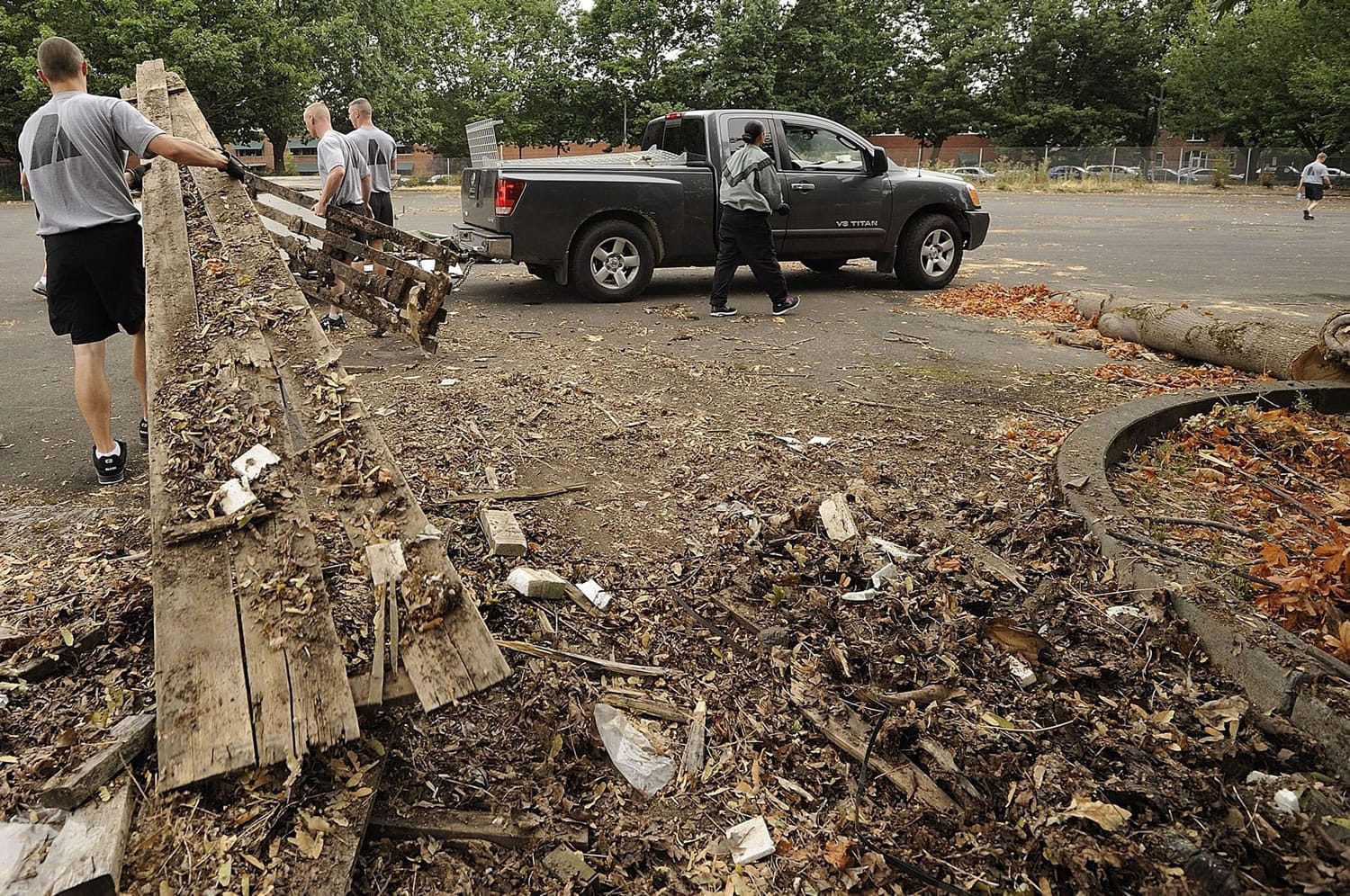Previously: In 1849, the first elements of the U.S. Army arrived at what was then Fort Vancouver.
What’s new: Military operations ceased at midnight Wednesday
at Vancouver Barracks.
What’s next: The 33-acre site is slated to be transferred to the National Park Service.
To learn more about Vancouver Barracks and tour the main buildings: Vancouver Barracks Columbian page.
An era ended at midnight Wednesday when military operations ceased at Vancouver Barracks.
After 162 years as a U.S. Army base during some defining periods of American history, the barracks site is preparing for a new role. It is destined to become part of the National Park Service, which operates the Fort Vancouver National Historic Site.
The midnight transition was another step in that process, as well as part of an initiative to restructure the nation’s military facilities.
Soldiers doing some final clean-up chores provided the only Army presence Wednesday at Vancouver Barracks.
“We will no longer be occupying Vancouver Barracks. Today, we’re clearing the buildings, making sure the Army Reserve units have moved out and left the buildings in good condition,” Scott McKean said Wednesday morning.
McKean, a civilian employee of the U.S. Army Reserves, is coordinator the Base Realignment and Closure (BRAC) program in Washington, Oregon and Montana.
Army Reserve and National Guard units that were based at the historic site have set up operations in a new military center in Sifton, 15005 N.E. 65th Ave., just south of Fourth Plain Boulevard.
“About 1,000 soldiers moved from the barracks to the new Armed Forces Reserve Center,” McKean said. “The move has been gradual over the last month and a half.”
After several previous reductions, the Vancouver Barracks site consists of 33 acres and 28 buildings, including 20 that are categorized as historic buildings, he said.
Tracy Fortmann, superintendent of the Fort Vancouver National Historic Site, said the park service recognizes the responsibility — as well as the opportunity — that comes with the transition.
“For us, it’s an honor,” Fortmann said. “For our veterans and military retirees, it’s the loss of a post that’s been here their entire lives. Even so, Vancouver Barracks is not lost. It’s our role to keep that story alive.”
One of those veterans recognizes the reality of the transition because he’s been part of it. Bob Knight, now president of Clark College, was the final commander of Vancouver Barracks.
When Knight arrived as a lieutenant colonel in February 1997, “the active duty presence had gone down to a dozen people,” he said.
“We knew the day was coming. I started the closure when I deactivated the barracks in August 2000. We allowed the Reserves to take it, and turned the West Barracks over to the city,” said Knight, whose 3½-year command ended in October 2000.
“The departure of the U.S. Army from the Fort Vancouver National Site after more than 160 years is an outcome we have come to accept with regret,” Elson Strahan, president and CEO of the Fort Vancouver National Trust, said in an email. The national trust is a partner in the transition.
“Clearly, the historical importance of the site is rooted deeply in the Army’s presence for more than a century and a half. When the site was congressionally chartered in 1996, it was envisioned that the Army would remain an active partner, but world events and the required flexibility of our U.S. military changed that assumption,” Strahan wrote.
There still are a few steps — and several other agencies — in the transition, McKean said.
For the immediate future, “it goes into a caretaker status,” said McKean, who also is coordinating a dozen other base closures in Washington, Oregon and Montana.
The Army has a target date of Nov. 1 for relinquishing the Vancouver Barracks property to the Bureau of Land Management, which eventually will transfer it to the National Park Service, McKean said.
There also is another partner in the process.
“The Army Corps of Engineers is the real estate agent for the Army, and works with transfers and ownership of land,” McKean said.
People who want some fresh air or a place for a stroll will continue to have access to the barracks grounds, said Bill Schell, who oversees operations.
“People will be able to walk through,” Schell said. “We will keep an eye on homeless activity, and we will be vigilant until it is transferred.
“We still have some projects to complete, like redoing the gutter system at the auditorium,” Schell said. “We are trying to get the buildings ready to be turned over in good shape.”
Other resources linked to the site are less tangible: the stories of the people who served there. Some historical figures — Ulysses S. Grant, O.O. Howard and George Marshall — have buildings bearing their names. But they’re not the only ones who contributed.
“From the many iconic leaders such as Marshall, Grant and Howard who were posted here, to the thousands of troops who served our nation as they were stationed at and deployed from this site, we owe a true debt of gratitude,” Strahan said.
Knight ran into plenty of those folks as barracks commander.
“People would come by all the time and tell me stories,” Knight said.
Some represented more than one era of history, including Nez Perce elder Horace Axtell. Axtell is a tribal spiritual leader who participates in an annual reconciliation ceremony at Fort Vancouver, commemorating the 1878 death of a Nez Perce child at the fort.
“Horace told me that as a young soldier, he deployed through Vancouver Barracks on his way to the Pacific,” Knight said. “There was a tremendous amount of history that went through Vancouver Barracks.”
Tom Vogt: 360-735-4558 or tom.vogt@columbian.com.




